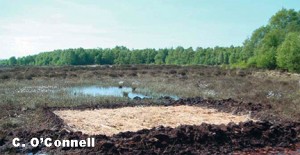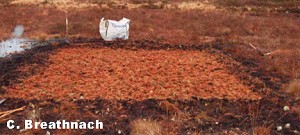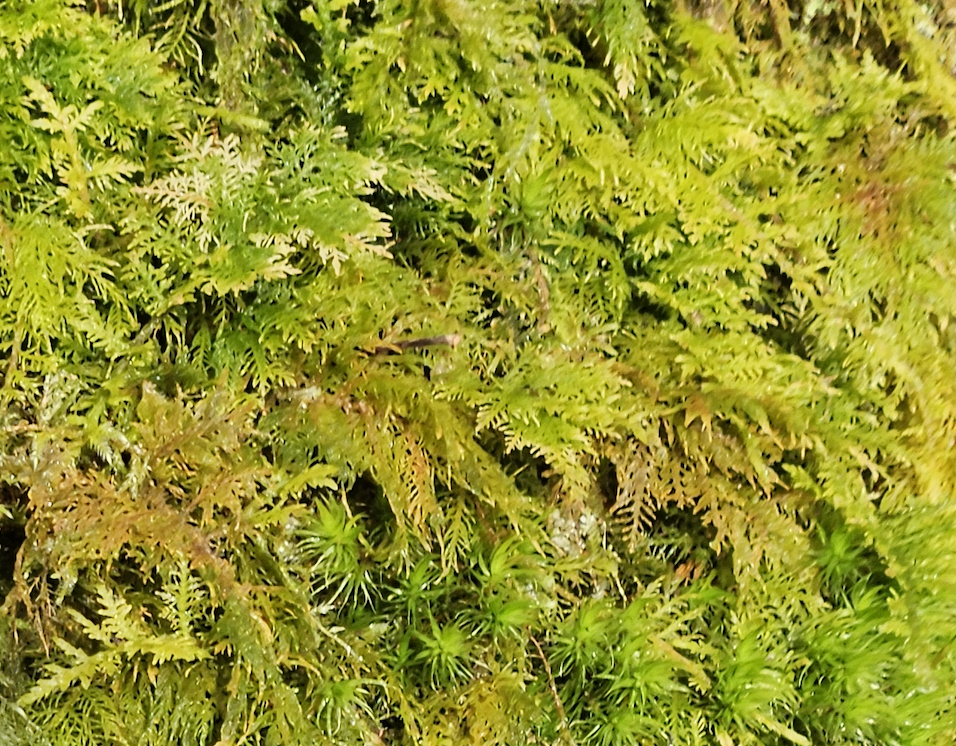

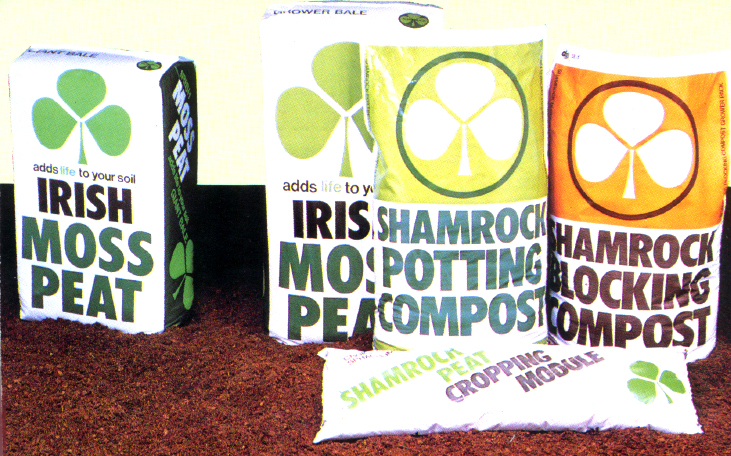
A key issue in the conservation of bogs in Ireland is restoring the peat forming function of sites that have been damaged by turf cutting. Turf cutting has been greatly modernised in Ireland. It is undertaken by contractors with industrial grade diggers who drain the bog and remove the peat forming layer of vegetation from its surface.
Blocking drains on bogs does raise water levels in the peat and the techniques have been widely used in Ireland. But the Sphagnum mosses which are responsible for building bogs do not naturally regenerate on the bare peat. Intervention is necessary to make the bogs recover their peat accumulating functions within a reasonable time scale.
The Canadian Approach
In Canada peatland managers have successfully developed techniques to cultivate Sphagnum mosses on an industrial scale on bare peat surfaces over a time line of just ten years. Peat formation is ensured by raising the water table through drain blocking and establishing a living layer of moss over a formerly dry, bare and eroding peat surface. Irish Peatland Conservation Council have been successfully trialing these methods in an Irish bog environment on our reserve – Lodge Bog since 2009.
The Canadian peatland restoration approach is based on the active reintroduction of peat bog plant species and hydrological management in order to raise and stabilise the water level. It consists of surface preparation, plant collection, plant spreading, straw spreading, fertilization and blocking drainage. The starting point for the restoration process is a relatively deep acidic peat substrate from which only horticultural grade peat has been removed.
- The surface dry crust of hard peat must be broken up so that plants introduced are in contact with the peat substrate. Harrowing machinery is used. Between 5 and 10cm of the surface may need to be milled depending on local conditions. In addition excessive loose peat should be removed.
- Dome shaped harvesting fields need to be reprofiled, i.e flattened. Ditches need to be filled in or blocked.
- Sphagnum is harvested from a donor site. The top 10cm are removed using a rotovator to first break up plant fragments and facilitate collection. This material is then spread using a back mounted manure spreader. The recommended harvest area to spread area ratio is 1:10 harvest:spread.
- Straw mulch needs to be spread over newly innoculated Sphagnum moss on the field surface using a blower. A minimum quantity to use is 3000kg per hectare. This represents 25 to 30 four foot bales per hectare (10 to 12 per acre). A sideward straw spreader may be used to apply the straw. The advantage of using a blower is that heavy machinery does not have to pass over plant fragments during straw application.
- Fertilization is carried out once all of the previous steps are complete. A weak dose of granulated rock phosphate fertiliser is used. Use of other types of phosphorus containing fertilisers is not recommended as the concentration phosphorus that they contain makes it difficult to get an even spread due to such a low application rate. Also, high doses of phosphorus promotes invasive species such as birch. Nitrogen fertilisers are not required as disturbed peatlands already contain enough nitrogen to support their native flora. Rock phosphate releases just enough phosphorus over a long enough period of time to help promote the growth of species such as Polytrichum moss. Polytrichum mosses act as nurse plants that in turn promote the growth of Sphagnum mosses. A dose of 150kg of rock phosphate per hectare is recommended. Care should be taken however when any phosphorus containing fertilizer is used near to a watercoarse so as to avoid contamination.
- Drain blocking is the final step in the restoration work. For further information see our page on Restoration of Drained Peatlands.
For a more detailed description of the methods described above download the Peatland Restoration Guide: Second Edition by Francois Quinty and Line Rochefort.
To see a short movie about the methods involved in restoring a raised bog with Sphagnum moss watch this movie.
Lodge Bog Sphagnum Moss Cultivation Trials 2009-2013
The photographs below show how the IPCC Sphagnum trial plots on Lodge Bog in Co. Kildare, Ireland. The plots measure 5m x 5m. Sphagnum capillifolium moss has been spread in one plot and this moss has been covered with straw in the other. Read IPCC’s poster paper presented to the International Peatland Society in 2015 about the successful five year Sphagnum restoration trials on Lodge Bog here.
On this site IPCC have also used the Sphagnum moss restoration method to restore part of Lodge bog that was badly trampled by visitors (2015) and to restore peat borrow pits created during the construction of peat dams to block drains (2017).
Girley Bog Sphagnum Moss Restoration 2014-2015
Following drain blocking and the creation of seasonal ponds in the cutover bog at Girley in Co. Meath, IPCC began a programme of Sphagnum moss restoration at this site. The work was funded by the Heritage Council through their grants scheme. Three Sphagnum moss restoration sites were established around temporary ponds and the results have been excellent as can be seen from the before and after images below.
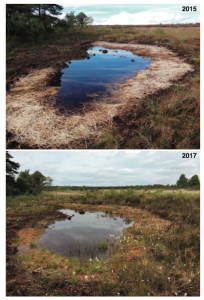
Left: Photos showing a successful Sphagnum inoculation site on Girley Bog, Co. Meath. The top photo shows the site just after inoculation when Sphagnum moss fragments were covered with straw in 2015. The bottom photo shows the same area in 2017 with a healthy Sphagnum moss growth. Photos: IPCC
Text, Photographs and Images © Irish Peatland Conservation Council, Bog of Allen Nature Centre, Lullymore, Rathangan, Co. Kildare R51 V293. Email: bogs@ipcc.ie; Tel: +353-45-860133.
Supported by the Community Foundation for Ireland and Kildare County Council

